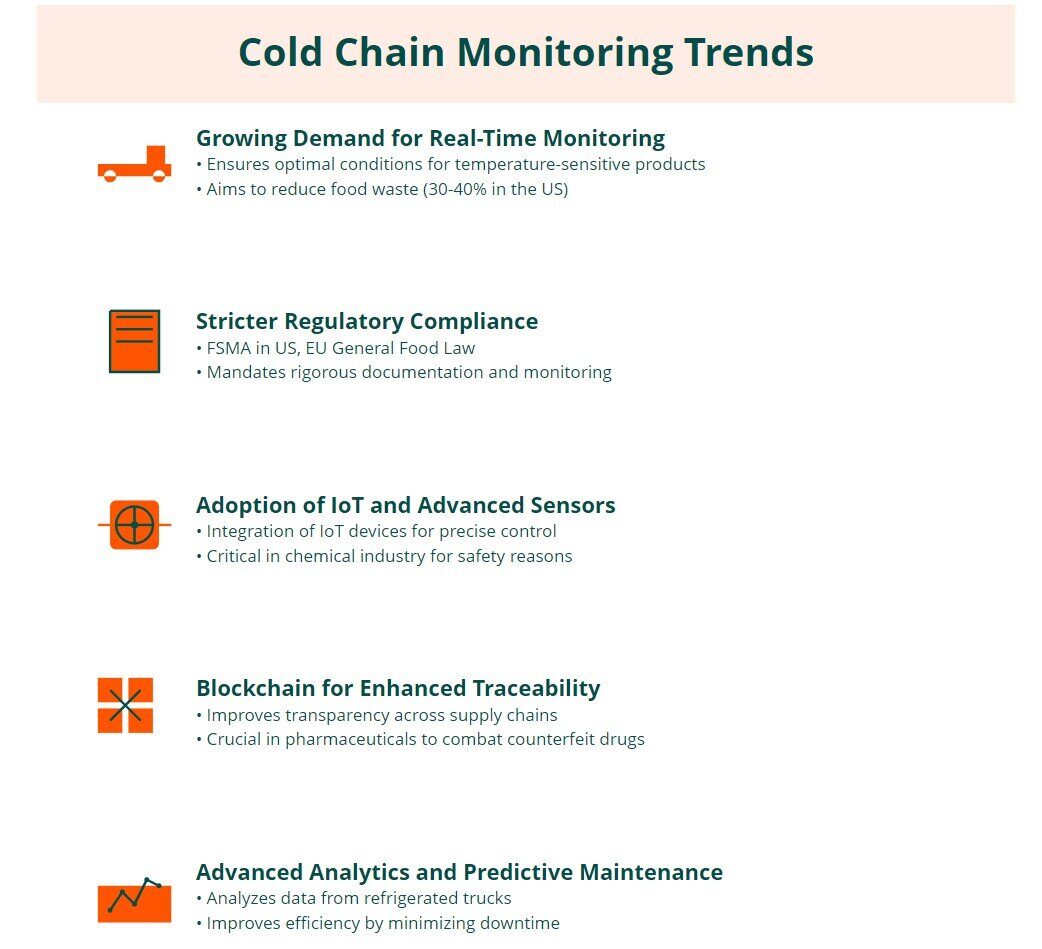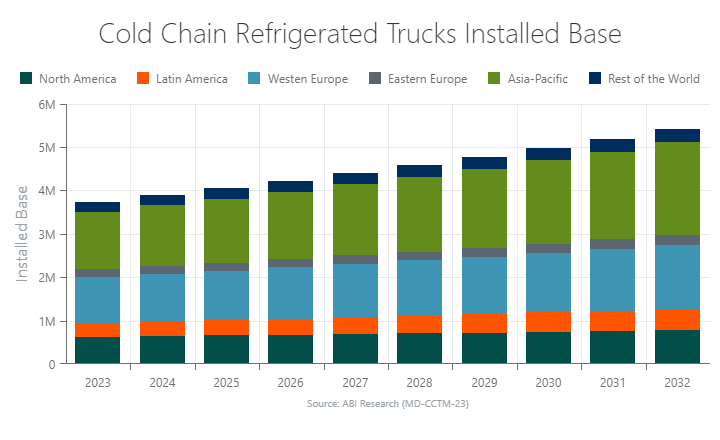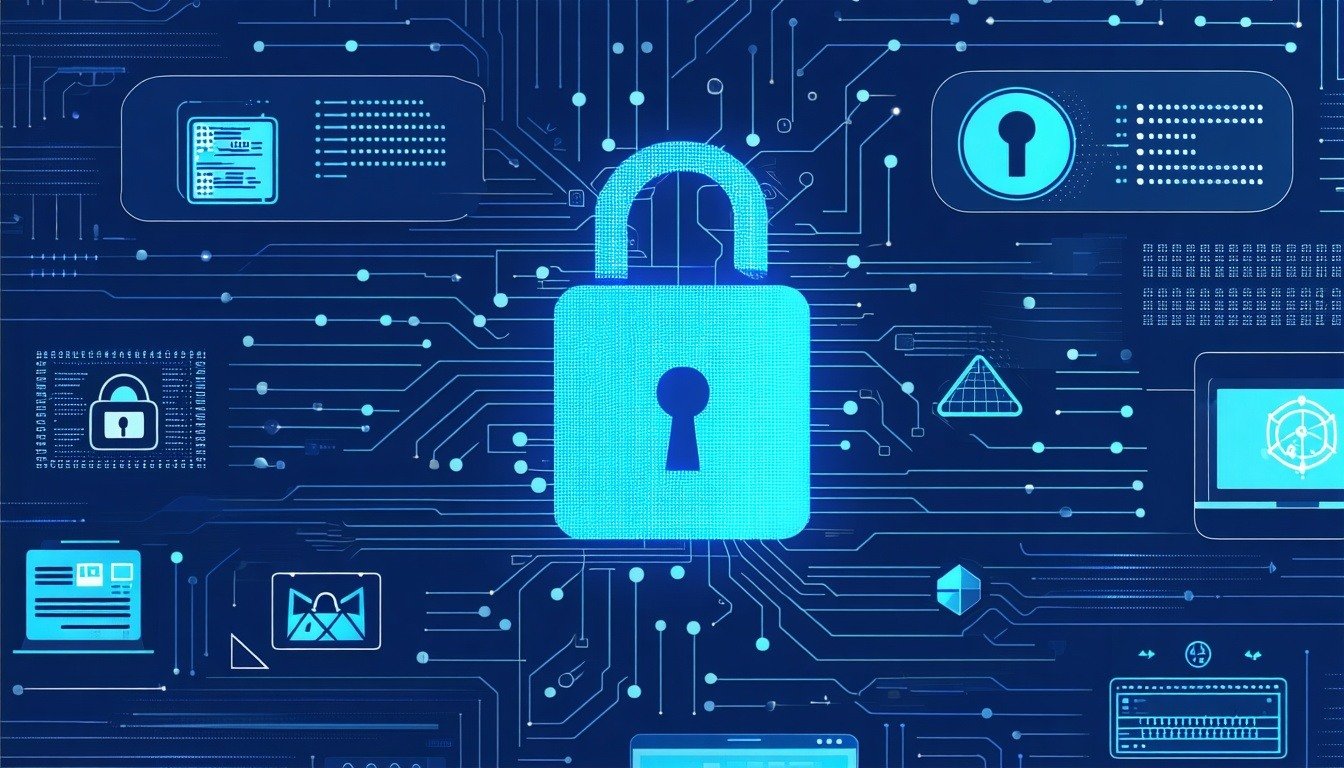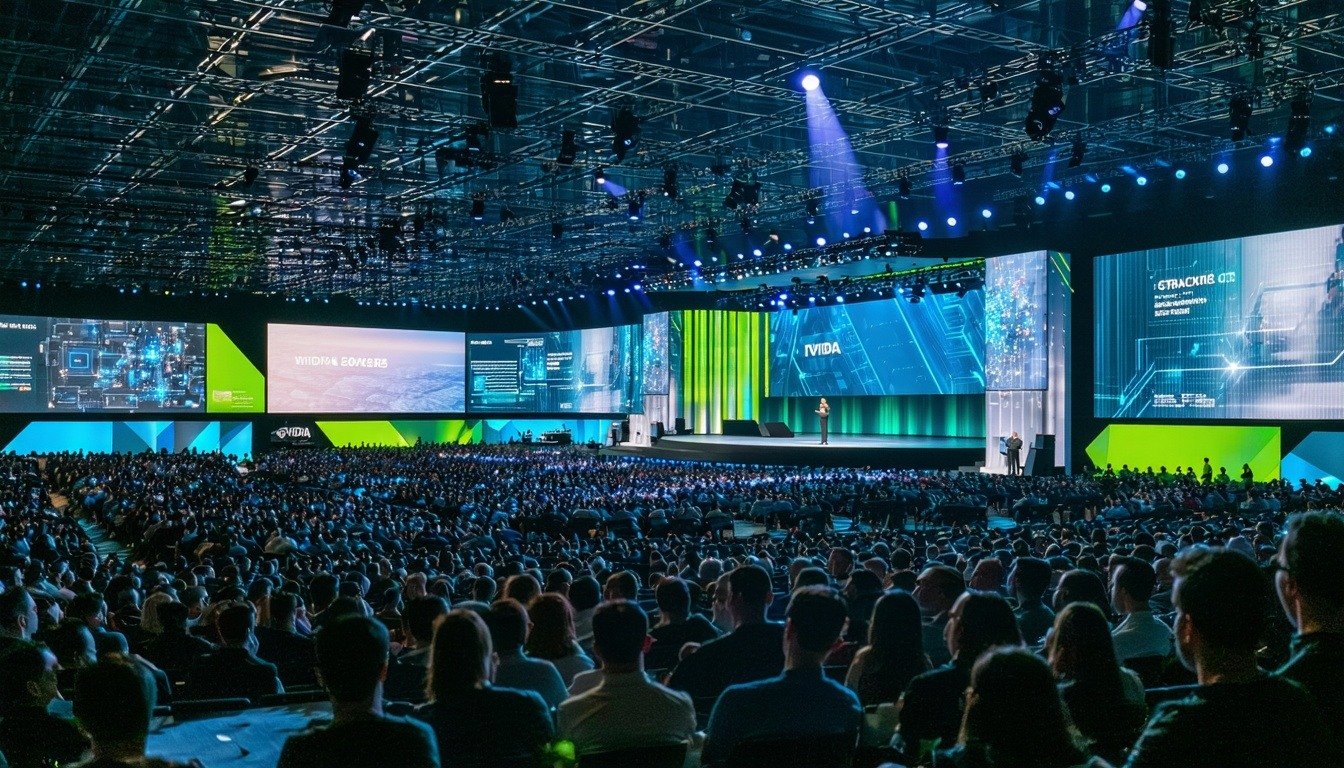If you manage a supply chain of temperature-sensitive products, cold chain monitoring can help minimize spoilage/waste and boost customer satisfaction. Products like vaccines, biologics, fresh produce, frozen food, and dairy must be stored in cool temperatures throughout the entire supply chain, or they risk becoming unsellable. Every year, the biopharma industry loses about US$35 billion because of a failure to implement temperature-controlled logistics. Even worse, the lack of temperature monitoring greatly contributes to the US$1 trillion of food waste annually. Cold chain technologies like temperature sensors and software platforms can help you avoid spoilage and comply with safety regulations.
See who the top cold chain monitoring vendors are in ABI Research's competitive ranking.
What Is Cold Chain Monitoring?
Cold chain monitoring is the process of monitoring and managing the temperature/humidity of vaccines, perishable goods, chemical products, pharmaceuticals, and other temperature-sensitive goods in transport or storage. A cold chain monitoring system relays real-time temperature data of goods to a centralized software platform. That way, you are alerted when a refrigerated container, pallet, or batch of products falls out of your set temperature parameters. This allows supply chain operators to take corrective action before food spoils, a vaccine/drug becomes unsafe to use, or a chemical loses its intended composition.
Figure 1: Current Trends in Cold Chain Monitoring

(Source: ABI Research)
How Does Cold Chain Monitoring Work?
Cold chain temperature monitoring requires storing perishable goods in a microclimate—a refrigerated truck, warehouse, or container. Cold chain monitoring typically involves attaching an Internet of Things (IoT) tracker at a batch/lot level by placing temperature sensors at different areas of the refrigerated truck/container to obtain temperature readings. The sensors measure the real-time temperature of the goods and send the readings back to a centralized software system. Fleet managers can track the real-time temperature and humidity levels of these trucks and containers and set triggers in case of temperature fluctuations via rules-based engines on the fleet management platform itself. Once a temperature excursion is detected, cold chain operators can make adjustments swiftly—whether by closing an open door, fixing a malfunctioning refrigeration unit, or remotely adjusting the temperature of the storage environment.

Cold Chain Monitoring Hardware and Software
Cold chain temperature monitoring requires both hardware and software solutions, as does any digital transformation journey. On the hardware side, tracking technologies like temperature sensors, data loggers, Global Positioning System (GPS) trackers, and Radio Frequency Identification (RFID) tags collect and transmit conditional/location data of temperature-sensitive products.
Cold chain software platforms are essential for organizations to analyze, manage, report, and contextualize the data generated by temperature sensors. These software platforms usually offer features like:
- Real-time monitoring
- Alerts and notifications about temperature excursions
- Data analytics
- Reporting tools
- Integration capabilities
- Wireless connectivity
Why Cold Chain Monitoring Is Needed
Several key reasons exist for the increased need for cold chain monitoring, including safety regulations, increased demand for fresh fruit and vegetables, food waste, and an uptick in cargo theft.
Food Safety Regulations
The U.S. Food Safety Modernization Act (FSMA) Section 204, the Hazard Analysis Critical Control Point (HACCP), and the European Union (EU) General Food Law are huge catalysts for cold chain monitoring solutions. These food safety regulations require supply chain players such as manufacturers, retailers, and logistics service providers to monitor the temperature of perishable products from the “farm to fork.”
Pharmaceutical Regulations
Like the food industry, pharmaceuticals are heavily regulated to prevent public safety issues. While 80% of EU-based pharmaceuticals already require temperature-controlled logistics, the U.S. Food and Drug Administration (FDA) is also ramping up its pharma safety efforts. A prominent example of pharmaceutical cold chain monitoring is the refrigerated storage of medical devices and vaccines.
Growing Preference for Fresh Food
Global demand for fresh fruit and vegetables is growing by over 3% each year. Consumers are becoming more health-conscious worldwide, necessitating investment in cold chain temperature monitoring to provide the highest-quality product possible. Moreover, cold chain telematics improves operational visibility, which is crucial for identifying supply chain bottlenecks between the farm and grocery store.
Food Waste
An estimated 7% to 15% of all food products—1.3 billion metric tons—go to waste each year in transit. While this US$1 trillion problem is partially attributed to missing cargo, temperature excursions along the supply chain are a common culprit.
Increased Cargo Theft
Largely spurred by document forgery, cargo theft was up 46% in 2023. With food prices increasing in recent inflationary years, this problem has been exacerbated. Real-time monitoring can help prevent cargo theft by detecting if a truck or its goods are not in the right location.
Benefits of Cold Chain Monitoring
Companies that monitor their cold chain shipments can expect the following key benefits.
Food and Drug Safety Compliance
Cold chain monitoring ensures that distributors and manufacturers comply with regional safety regulations for food and drug products. Failure to comply could result in monetary penalties or the prohibition of doing future business.
Customer Satisfaction
No consumer seeks a bruised banana, an unripe apple, or spoiled milk. Likewise, healthcare providers will hesitate to do future business with companies that fail to meet delivery windows due to temperature control shortcomings. Identifying and addressing temperature/environmental excursions early maximizes product quality and keeps customers happy.
Supply Chain Visibility
Cold chain telematics offers another layer of supply chain visibility. In addition to tracking products' real-time temperature and humidity, you can track where cargo is located and inform supply chain partners of Estimated Times of Arrival (ETAs).
Increased Profits
Cold chain monitoring reduces food waste, optimizes supply chain resources, helps prevent theft, and ensures avoidance of regulatory fines. Together, manufacturers and their supply chain partners can maximize operational profitability. Moreover, high-quality perishable products result in longer-term customers.
Examples of Cold Chain Monitoring
PepsiCo, Walmart, and Tyson Foods are three prominent Consumer Packaged Goods (CPG) manufacturers/retailers that have invested in cold chain monitoring. These food & beverage/retail giants have adopted IoT tracking technologies that help sustain adequate temperatures throughout the entire supply chain.
- PepsiCo: PepsiCo has positioned itself as a leading technology innovator by deploying various cold chain solutions. The company’s investment efforts have focused on eco-friendly refrigerated trucks, IoT-based temperature monitoring, and end-to-end supply chain visibility software. Moreover, PepsiCo maintains close ties with leading cold chain logistics providers and farmer-facing organizations to leverage their expertise.
- Walmart: Walmart's cold chain investment includes fleets of temperature-controlled refrigerated trucks, cold storage warehouses and distribution centers, ambient IoT, and innovative cooling technologies/materials. Walmart also leverages demand forecasting to keep inventory levels low, making cold chain storage more efficient.
- Tyson Foods: With a vertical supply chain, Tyson Foods manages its supply chain partners from farm to first-line handlers. Vital monitoring solutions such as real-time temperature/humidity tracking and refrigerated warehouses/distribution hubs have made Tyson Foods a leader in food quality and safety. The company’s close collaboration with refrigeration technology suppliers and cold chain logistics partners is an important enabler of its cold chain monitoring capabilities.
ABI Research’s Cold Chain Tech Intelligence
Cold chain monitoring is a core focus of ABI Research’s Supply Chain Management & Logistics Research Service. Our analysts identify key trends shaping the modern cold chain, share market data forecasts, and keep you up to date on the latest technologies that enable you to adhere to food/drug safety regulations and achieve the highest quality product shipments possible. Below are a few recent ABI Research reports that help support cold chain managers in their technology implementation:




